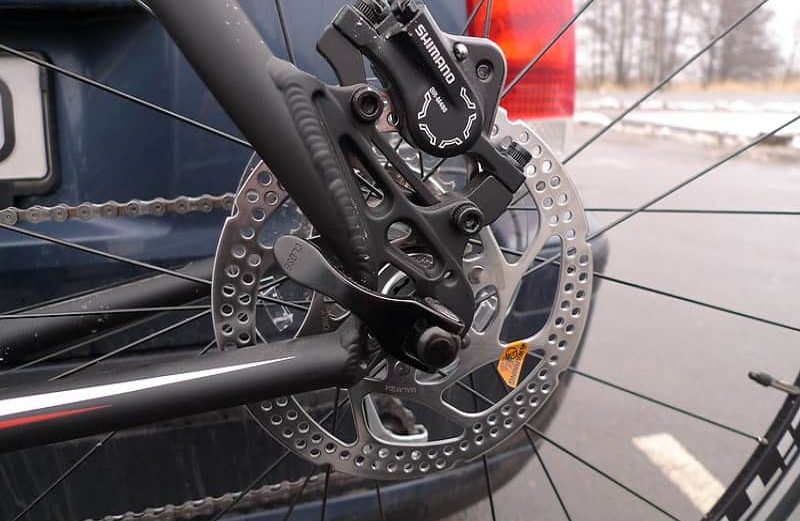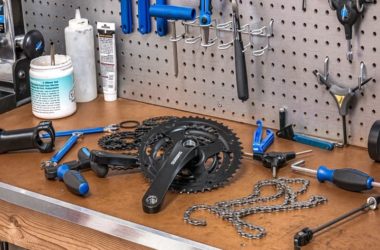Why it is important to know How To Adjust Bicycle Disc Brakes? The smallest answer to your question is you can ride rub-free and stop with confidence. Calibrate disc offers outstanding braking modulation including lots of power whatever the weather. How To Adjust Bicycle Disc Brakes? Also supports the use of bigger tires than top brakes. Bike disk brakes don’t care if your wheel is a bit twisted. Quiet, expected the rub-free operation depends on fractions of mm of a margin between pad and rotor though.
In this article, we at BestComfortBike will give a complete guide on the important topic of How To Adjust Bicycle Disc Brakes. You will be grateful that you have read this article & choice the best idea for You! Let’s get started!
Table of Contents
You Might Also Like ⇒
- Mechanical Vs Hydraulic Disc Brakes
- Best Bike Brake Pads
- Disc Brakes Vs Rim Brakes
- Road Bike Brake Pad
- Best Beginner Road Bike
- Best Road Bikes Under 500
- Tour Bike Vs Road Bike
- Best Mountain Bikes Under 1000
- Best Fat Bikes Under 2000
- BCB Bicycle Handlebar Grips Fit Many Standard Bikes
- BCB Mountain Bicycle Soft Rubber Grips Fit Many Standard Bikes
- BCB Bicycle Grips For BMX/Road Mountain/Boys And Girls Kids Bikes
- BCB BMX & Mountain Bike Handlebar Grips Non-Slip Soft
- BCB Mountain Bike Handlebar Grips, Two Colour
Guide: How To Adjust Bicycle Disc Brakes

Disc brakes are one of the most common types of brakes found on bicycles. This style of bike disc brakes has 2 pads that press on either side of the wheel’s rotor (a flat, perforated metal disc) to slow down the bike.
Types of Bike Disk Brakes
Disc brakes come in 2 common categories:
- Hydraulic: Bike Brakes Caliper
- Mechanical: Bike Disk Brake Pads
How To Adjust Bicycle Disc Brakes? If the front disk brake rubbing on the rotor when you ride the bike, you can adjust them yourself with an Allen wrench. but in the case of tightening bike brakes, you need to have the proper kit and know how to adjust mountain bike brakes.it means a simple Allen wrench is not enough in adjusting brakes on a bicycle.
I suggest you read this article just to vanish all the confusion while adjusting bike disc brakes.
Tools: Need To Adjusting Bike Disc Brakes
- 5mm Allen Key: You’ll need a 5mm Allen key or Torx T25 key depending on the mounting bolts of your brakes.
- Wide Screwdriver: A wide screwdriver, broad tire lever, or similar flat lever can be useful for resetting the brake cylinders.
- Slotted Rotor: A slotted rotor straightening tool or large, clean adjustable spanner will be needed to straighten a bent rotor.
After collecting all these tools you should have a complete knowledge of how and where all these tools can be used for this I suggest you read methods about How To Adjust Bicycle Disc Brakes? there are several methods for fixing brakes on a bike some of them are given below :
Method 1: Assessing Your Brakes While Bicycle Disc Brakes Maintenance

- Set Bicycle In A Bicycle Stands For Adjusting Brakes. When you arrange your bicycle’s disc brakes, the wheel should be raised off of the ground so it can spin easily. If you have a bicycle stand, put your bicycle in the stand so it’s held in place and raised off the ground. If you do not have a bicycle stand, just flip your bicycle upside down so that the seat and handlebars are on the ground and the wheels are sticking up
- Figure Out Which Style of Disc Brakes You Have While Fixing Disc Brakes on A Bicycle: Look closely at the calliper at the centre of each of your bicycle’s wheels. If the bicycle’s callipers have a small cable running to them, they are mechanical bike disk brake pads. If the callipers don’t have any attached cables, they’re hydraulic bike brakes calliper. If you’re still not sure which style you have, snap a photo of your bike’s brakes and take it to a local cycling shop.
- Tighten Your Wheel In The Drop House Before Adjusting The Brakes On A Bicycle: A bike’s drop house is a they-shaped frame that the wheel sits between. The drop house attaches to both sides of the wheel and keeps it connected to the bike. Make sure that the wheel is firmly in place by turning the lever on the side of the wheel clockwise. Once you’ve tightened the wheel, fold the lever in until it’s flush with the wheel.
- During Adjusting Shimano Disc Brakes Avoid Touching The Edge of The Rotor So You Don’t Cut Yourself. The rotor (the circular metal disc that disc brakes apply force to) can be very sharp. As you’re adjusting your disc brakes, try not to touch the edge of the disc. Hold the disc by placing your thumb and fingers on the disc’s 2 flat sides.
Method 2: Adjust Hydraulic Brakes For Bike Disc Brakes Maintenance

- If The Brakes Rub During Fixing Breaks On A Bicycle: Loose the 2 bolts on The Side of Your Caliper, If you can hear your bike disc brakes rubbing as you drive your bike around, it’s a sign that the brakes are too tight. Examine the calliper and find both of the 1⁄8 inch (0.32 cm) hex bolts that hold the calliper to the frame. Insert an Allen wrench of a similar size and twist it a half-turn counterclockwise. This should loosen the brakes enough that they stop rubbing. The disc brakes may be too tight on only 1 wheel. In this case, you will not need to tighten the brake on your other wheel.
- For Adjusting Shimano Disc Brakes Squeeze: The brake lever 2–3 times to centre the calliper on the rotor. After you’ve loosened the 2 hex bolts, squeeze the brake lever that matches with the wheel you’re adjusting. If you bumped the calliper while you were loosening it, this will re-centre it on the rotor disc. On the last squeeze, keep pressure on the brake lever. The right-hand brake lever controls the rear brake and the left-hand brake lever controls the front brake.
- Before Releasing The Lever Tighten The Bolts By A Half Turn For Bike Disk Brakes Maintenance: With the similar brake lever held down, again insert the Allen wrench into 1 of the 2 hex bolts. This time, turn the wrench a half-turn clockwise to tighten the calliper around the rotor. Tighten the second hex bolts as well.
- While Adjusting The Brake On A Bicycle Spin The Wheel To Make Sure That The Rubbing Has Stopped: Make sure that the wheel is faultless and can turn freely. Give the wheel a firm spin (in either direction). Listen for the sound of rubbing.
- If The Brakes Still Rub During Tuning Bicycle Disc Brakes Align The Caliper Visually Over The Rotor: If the brakes continue to rub, loosen the pipes by a quarter turn. Look down from the top of the calliper and visually align it so that it sits directly over the rotor. With the brake lever held down, fine-tune the position of the calliper so that it’s fully centred. Then, tighten the hex bolts a quarter turn.
Method 3: Tweaking Mechanical Brakes For Bike Disc Brakes Adjustment

- On the side of The Caliper Loosen The Small Set Screw: Some models of mechanical disc brakes have a small “set” screw that clamps down on the calliper’s adjustment dial to prevent it from loosening while you’re riding the bike around. Use a small Philips head screwdriver to turn the set screw 1–2 full rotations counterclockwise.
- To Adjust The Brakes, Twist the Adjustment Dial On The Side of The Caliper. Most bikes with mechanical disc brakes have a 1 inch (2.5 cm) wide plastic dial on the side of the Caliper (right next to the wheel’s spokes). Turn the wheel clockwise to move the brake pad closer to the rotor and counterclockwise to move it farther away from the rotor.
- To Make Sure That The Brakes Tighten Squeeze The Brake Lever: Give the lever that corresponds to the brake that you’re adjusting a firm squeeze. The 2 pads should tighten on either side of the rotor. Both of the pads should touch the rotor disc at the same time; if 1 touch before the other, the rotor isn’t properly centred beneath the calliper.
- Set Screw Before Riding Your Bike & Tighten The Hex Bolts: Use your Allen wrench to turn the 2 hex nuts on the side of the calliper clockwise. Even if you didn’t loosen them when you were adjusting your mechanical disc brakes, check to make sure that the hex bolts are tight. Also, use your screwdriver to tighten the small set screw that you loosened earlier.
Advantage And Disadvantage of Adjusting Bike Disc Brakes

Benefits Of Adjusting Bike Disc Brakes
- Better Braking Power: Bicycle disk brakes produce far more braking power than standard rim brakes. For the rider, this means having to apply far less pressure on the brake levers, decreasing muscle tiredness, especially on long descents where you are constantly having to check your speed.
- Steady Braking: Depressing the lever of a rim brake is not always going to give you the same level of braking equal to the force you have applied, but with bicycle disc brakes, braking force is much more compatible. This means as a rider you’ll be able to judge more carefully how much force to apply to the brake lever to get the desired amount of braking.
- Reliability In Wet Weather: Compared with a rim brake a calibrate disc performs much better in wet weather. With a disc brake, you don’t get that slight delay in braking which is caused on a rim brake as it first has to displace water from the rim before biting on the surface. Disc brakes by their position on the bike and the fact they are self-contained are generally protected from wet conditions, so wet weather performance is largely unaffected.
- A Faster Ride: It is considered that disc brake bikes can provide a faster ride. As riders will have more trust and braking power on discs they can brake fractionally later than if they were using rim brakes. This will mean that they spend more time travelling at higher speeds as they are spending less time on the brakes.
- Reduced Corrosion On Wheels: Rim brakes inevitably cause corrosion on the rim surface, especially when combined with grit and dirt in winter, meaning that wheels will wear out far quicker than those on a disc brake-equipped bike. Moving the braking point of contact away from the rim means that there is no heat build-up on the rim and this decreases the chance of damage to the inner tube or tire.
- Brakes Unaffected Even When The Wheel Is Not True: As anyone who has damaged the rim on a wheel or their wheel is out-of-true will know, this can present a problem for rim brakes will have to be loosened off (or the wheel straightened) to prevent them catching on the rim. Disc brakes don’t have this problem and continue to work effectively even if the wheel is slightly out.
- Better Clearance: Without the use of a brake calliper on either side of the wheel rim, this has allowed the use of much wider tires on road bikes. A wider tire increases grip and comfort on a ride. More clearance also allows ease of fitting of mudguards for winter which typically would often have been much more of a nightmare task with certain types of calliper brakes.
Drawbacks Of Adjusting Bike Disc Brakes
- Disc Brakes Weigh More: When road cyclists are often doing everything they can to make their bike as light as possible for speed reasons, the addition of discs brakes will add weight to a bike. Disc brakes, especially hydraulic disc brake systems, are generally heavier than rim brakes.
- Higher Price: Bicycle Disc Brakes are a costlier option both from the point of view of initial purchase and maintenance. Although disc brake pads will generally last longer than rim pads they are costlier to replace and can be as much as three times the cost of similar rim pads.
- The Difficulty of Maintenance: Hydraulic bicycle disc brakes shouldn’t need much in the way of day-to-day maintenance because they are sealed, but when something goes go wrong this can be more difficult to reform. Occasionally disc brakes may need ‘bleeding’ if there is an air bubble trapped in the system, which isn’t a straightforward task as say adjusting a calliper rim brake.
- Not Portable: You couldn’t just transfer disc brakes onto your road bike that has previously been set up for rim brakes and vice versa. The frame and wheels would not accommodate both types. To use disc brakes you’d need a different wheel hub than on standard rim brake wheels, and the fork would need brake mount tabs to adjust disc brakes on a bicycle.
- Disc Brakes Can Be Dangerous: Problems can arise when riders in a group are using a mix of disc and rim braking systems, meaning that some can brake with different effects than others. In some situations, riders have claimed they have been injured by a disc brake following race incidents. However, the governing body for cycling, Union Cycliste International (UCI), has after extensive testing, authorized the use of disc brakes in the pro peloton. That year saw the first winner of a Tour de France stage using disc brakes. Discs had already been permitted for use for cyclo-cross, mountain bike, trials, and other mass participation events and their use is likely to generate across the whole pro peloton.




